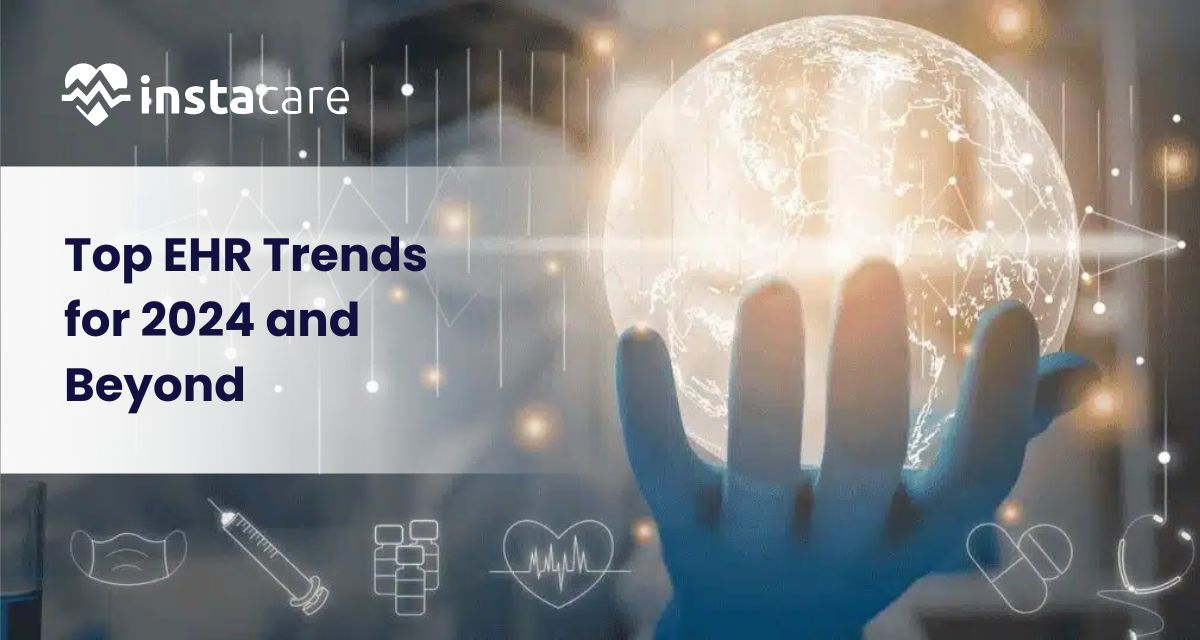Last updated on Friday, 26, July, 2024
Table of Contents
Top EHR Trends for 2024 and Beyond: What You Need to Know
In the ever-changing healthcare environment, EHRs become prominent considerations in improving patient care, raising efficiency, and innovating healthcare. Entering 2024 and beyond, various EHR trends are in line to shape the future of EHR systems, ready to turn a new leaf in how healthcare providers deliver services and handle information related to their patients.
Electronic health records have evolved from simple digital storage of a patient’s information to comprehensive systems that facilitate efficient healthcare delivery. Such systems offer more than just storage for the data of patients: they offer ways through which healthcare providers can make informed decisions, engage patients, and streamline administrative tasks in healthcare organizations. For healthcare providers who want to leverage technology to ensure improved patient outcomes and operational efficiency,
Staying Informed On The Latest EHR Trends is Relevant.
1-Artificial Intelligence and Machine Learning Integration
One of the gigantic steps in health technology is Artificial Intelligence and Machine Learning that are both integrated into the EHR Trends. Fundamentally, AI algorithms do analysis in blocks of vast amounts of data in EHRs, find patterns in them, and help to predict outcomes, hence acting as decision-supporting systems for the clinician. For example, it will help in disease diagnosis, readmissions, and tailoring treatment plans with respect to historical data tapering to the needs of specific patients. The learning process of ML algorithms never stops; it refines its insight with any new data input to enhance accuracy. One trend that would accelerate in 2024 is empowering health providers for proactive and personalized outpatient care.
2-Interoperability and Data Exchange
Interoperability remains a highly critical issue within healthcare, but several developments help in smooth interoperability between different EHRS systems and healthcare providers. Interoperable EHRs allow secure patient information availability and sharing over several healthcare settings, thus enhancing coordination in care and lightening the administrative burden. Standardized protocols and APIs are critical to interoperability; they enable efficient communication across interoperating systems, providing clinicians with a complete view of patient data at the point of clinical decisions.
3-Telehealth and Remote Patient Monitoring
The COVID-19 pandemic increased the adoption of telehealth services, clearly bringing into focus the need to integrate telehealth capabilities with the EHR. In 2024 and beyond, EHRs are likely to further facilitate telehealth visits, including virtual consultation, remote patient monitoring, and care for chronic conditions. Connected RPM devices to EHRs allow for the constant monitoring of patients’ vital signs and health metrics, providing data in real-time to the clinicians and truly empowering patients with self-management capability.
4-Blockchain for Data Security
Blockchain technology has recently been under extremely widespread attention in healthcare due to its promising capability of strengthening EHR security, promoting data integrity, and ensuring patient privacy. This data is gathered and secured by blockchain through the decentralization of data storage, aided by cryptography. Smart contracts within blockchain networks can facilitate automation of health care transactions, from processing insurance claims to supply chain management. At the same time, this powerful tool was available to safeguard sensitive health information against ever-changing cyber threats and maintaining patient confidence in EHRs.
5-Patient-centered design of EHR
User experience and principles of patient-centered design are increasingly playing their roles in EHR system development. It puts many efforts into enhancing the usability, intuitiveness, and accessibility of the EHR interface in contemporary EHR interfaces. The features are pointed at enhancing the efficiency of clinician workflow with increased patient engagement. For example, using patient portals for the lookup of all personal health records to schedule appointments easily and have real-time communication with health professionals. This can facilitate the better adoption of EHRs among clinicians and can also foster better relations between patients and providers.
6-Data Analytics and Population Health Management
Having voluminous data backed by the EHRs offers opportunities concerning the use of analytics to drive population health management ventures. The data analytics tools physically located within EHR systems analyze aggregated patient data to determine trends in population health, assess disease burden, and predict healthcare resource needs. Those health organizations can therefore apply such findings to institute targeted interventions and ensure improved public health and enhanced efficiency in resource allocation as a result. With predictive analytics, EHRs allow proactive healthcare delivery, which will lead to favorable patient outcomes and lesser costs to the healthcare sector.
7-Mobile EHR Applications
The areas revolutionizing healthcare delivery include mobile technology; more healthcare providers have started using mobile EHR applications. Mobile EHR applications will help clinicians view patient information on-the-go, supporting flexibility and efficiency in the delivery of care. Some of the functionality that this type of application supports includes the following: electronic prescribing, clinical documentation, and instant messaging among members of health teams. Equipping clinicians with mobile, secure access to EHRs empowers healthcare organizations with care coordination and response time to most significantly enhance the overall state of patient satisfaction.
8-Regulatory Compliance and EHR Standards
It remains to be that powerful force for regulatory compliance which turns out to be what many healthcare organizations attain when applying and managing systems of EHRs. In 2024, adherence to such regulatory provisions as the United States’ Health Insurance Portability and Accountability Act, Europe’s General Data Protection Regulation, and other local data protection laws around the world will go on and play a pervasive role in the development and implementation strategies of the EHR. Healthcare professionals should ensure, therefore, that their EHR systems meet industry standards and regulations regarding the safeguard of patient data privacy to avert risks and regulatory penalties.
Conclusion
The fast-changing technology and healthcare requirement drive the future of Electronic Health Records. These constitute the key trends that healthcare organizations need to adopt and pursue beyond 2024, seeking to unlock this enormous potential of EHRs toward enhancing the quality of care provided to patients, underpinning clinical decision-making, and boosting operational efficiency. Therefore, investing heavily in AI-driven insights, interoperable systems, telehealth capabilities, blockchain security, patient-centered design, data analytics, mobile applications, and regulatory compliance will position the model for a connected, efficient, and more patient-centered model of health care.
FAQs
1-What is the role of artificial intelligence in the future of EHRs?
AI will further push the EHR systems by allowing predictive analytics and personalized medicine recommendations from the automated analysis of data. AI algorithms dive deep into the depths of patient information to find patterns and insights to inform decision-making for the clinician in patient care.
2-What are EHR systems doing to resolve interoperability challenges?
Although interoperability within healthcare still remains a challenge, efforts are being advanced to standardize protocols of health data exchange and integrate APIs into the EHR. This will ensure seamless communication between various providers of healthcare services and care coordination across the numerous, different healthcare settings.
3-What are some of the benefits of integrating telehealth capabilities with an EHR?
Integrated telehealth capabilities allow providers to conduct virtual consultations, remotely monitor patients, and manage chronic conditions without requiring a physical visit from patients. This would improve access to healthcare, help reduce healthcare costs, and enhance convenience to patients—especially in rural or underserved locations.
4-How could blockchain technology be used in securing the features of EHRs and patient data privacy?
What the blockchain technology brings to EHR is decentralized data storage, along with corresponding cryptographic security measures, that guarantee it is tamper-proof and resilient to unauthorized access. This makes blockchain relevant to healthcare organizations that have to further increase the integrity of health data and smooth healthcare transactions, including patient confidentiality, for increasing trust in EHR systems.



